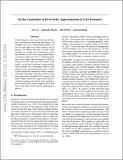On the limitations of first-order approximation in GAN dynamics
Author(s)
Madry, Aleksander
DownloadSubmitted version (786.2Kb)
Open Access Policy
Open Access Policy
Creative Commons Attribution-Noncommercial-Share Alike
Terms of use
Metadata
Show full item recordAbstract
© Copyright 2018 by the author(s). While Generative Adversarial Networks (GANs) have demonstrated promising performance on multiple vision tasks, their learning dynamics are not yet well understood, both in theory and in practice. To address this issue, we study GAN dynamics in a simple yet rich parametric model that exhibits several of the common problematic convergence behaviors such as vanishing gradients, mode collapse, and diverging or oscillatory behavior. In spite of the non-convex nature of our model, we are able to perform a rigorous theoretical analysis of its convergence behavior. Our analysis reveals an interesting dichotomy, a GAN with an optimal discriminator provably converges, while first order approximations of the discriminator steps lead to unstable GAN dynamics and mode collapse. Our result suggests that using first order discriminator steps (the de-facto standard in most existing GAN setups) might be one of the factors that makes GAN training challenging in practice.
Date issued
2018Department
Massachusetts Institute of Technology. Department of Electrical Engineering and Computer Science; Massachusetts Institute of Technology. Computer Science and Artificial Intelligence LaboratoryCitation
Madry, Aleksander. 2018. "On the limitations of first-order approximation in GAN dynamics."
Version: Original manuscript